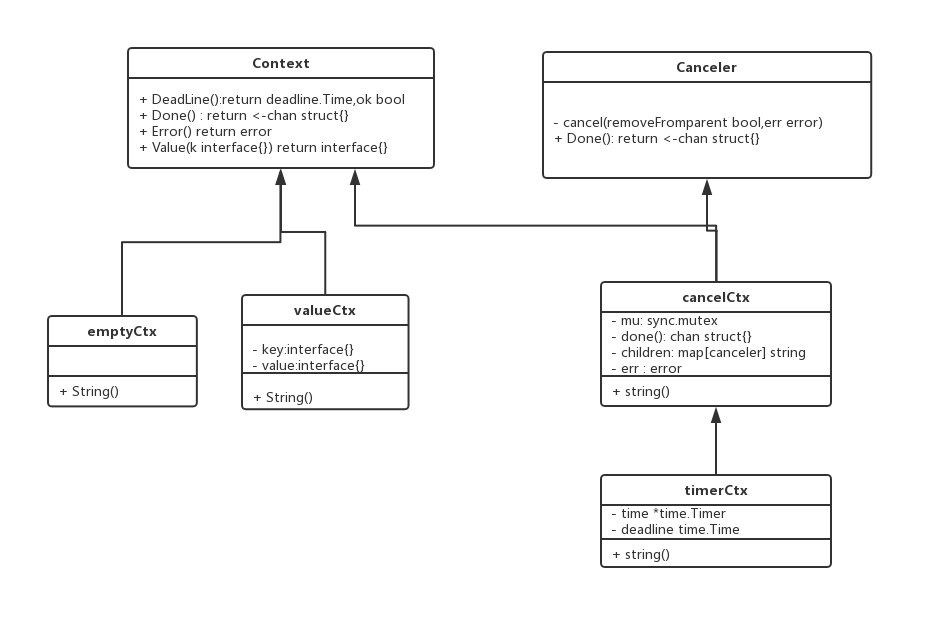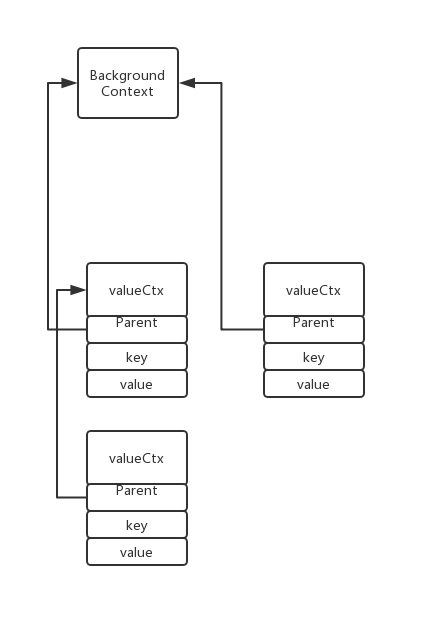Golang Context
Golang出色的协程为其增添不少色彩,而Context在协程间的协作,同步发挥了很大的作用

作用
开头已经说道,Context主要用于在goroutine之间传递上下文信息,而这些信息包括key-value pair,cancel信号,timeout信号等 http包,sql包里面都用到了context,比如http包里面,API可以由外部执行cancel操作,可以设置timeout信号来cancel http请求服务如果过慢,则可以用timeout进行释放资源 举例:获取商品的默认库存数量等
参考 go在今日头条的实践
另外,之前的
源码
可以参考官方blog
整体提供了:
| Name | Type | Usage | Comment |
|---|---|---|---|
| Context | Interface | Define four methods: Deadline() (deadline time.Time, ok bool) Done()<-chan struct{} Err() error Value(key interface{}) interface{} |
|
| emptyCtx | struct | Also define interface, but it's empty | |
| CancelFunc | func | cancel func | |
| CancelCtx | struct | mark as cancelable | 都有实现自己的方法 Cancel() |
| timerCtx | struct | canceled if timeout | |
| valueCtx | struct | save K-V pair | |
| Background | func | Background returns a non-nil, empty Context. It is never canceled, has no values, and has no deadline. It is typically used by the main function, initialization, and tests, and as the top-level Context for incoming requests. |
返回空的context,常用做top-level context |
| TODO | func | TODO returns a non-nil, empty Context. Code should use context.TODO when it' s unclear which Context to use or it is not yet available (because the surrounding function has not yet been extended to accept a Context parameter). TODO is recognized by static analysis tools that determine whether Contexts are propagated correctly in a program. |
返回空的context |
| WithCancel | func | Based on parent context, generate a cancelable context | 基于父context生成可取消context (自然就会调用下面的propagateCancel) |
| newCancelCtx | func | create a cancelable context | 返回一个CancelCtx |
| propagateCancel | func | propagateCancel arranges for child to be canceled | 向下传递context的关系 |
| parentCancelCtx | func | parentCancelCtx follows a chain of parent references until it finds a *cancelCtx. This function understands how each of the concrete types in this package represents its parent. |
找到第一个可取消的父节点 |
| removeChild | func | remove child | 去掉父节点的孩子节点 |
| init | func | init this package | |
| WithDeadLine | func | Create a context with deadline | 同理,都是为了创建不同功能的context |
| WithTimeout | func | ||
| WIthValue | func | ||
context里面的类图:

如上图所示,展开
Interface
Context
type Context interface {
//deadline会返回 这个context应该被取消的时间, 如果ok==false,指没有deadline设置(即返回deadline的时间或者返回没有设置deadline)
Deadline() (deadline time.Time, ok bool)
//返回一个关闭的只读channel ,代表着这个context应该被cancel或者到了deadline
Done() <-chan struct{}
//channel Done()关闭后,返回关闭原因
Err() error
//获取key对应的value值
Value(key interface{}) interface{}
}关于 Done() 需要注意的是这个是一个只读 的 channel!
- 只有在其被关闭后,才可以从里面读出值, 而且这个值是相应类型的 零值,所以goroutine可以在其关闭后读出零值,判断后继续做后面的事情
- 其具有关联性,即所有用到这个context的goroutine,一旦有一方关闭了(Done()),其他的也会被关闭
Canceler
// A canceler is a context type that can be canceled directly. The
// implementations are *cancelCtx and *timerCtx.
type canceler interface {
cancel(removeFromParent bool, err error)
Done() <-chan struct{}
}源码说的很清楚了,这个接口会被 *cancelCtx和 *timerCtx 实现
//todo 为啥 Canceler里面有 cancel(),而Context里面 没有呢,是种设计问题吧?context有一些不会用到cancel,比如emptyCtx?
struct
emptyCtx
这个暂时略过,只要知道把这个当成一个占位符即可,有些函数可能以后会用到context,暂时把它当作一个参数传进去而已 它的相关方法有background() 和 TODO()
// An emptyCtx is never canceled, has no values, and has no deadline. It is not
// struct{}, since vars of this type must have distinct addresses.cancelCtx
// A cancelCtx can be canceled. When canceled, it also cancels any children
// that implement canceler.
type cancelCtx struct {
Context
mu sync.Mutex // protects following fields
done chan struct{} // created lazily, closed by first cancel call
children map[canceler]struct{} // set to nil by the first cancel call
err error // set to non-nil by the first cancel call
}这个cancelCtx 有实现了接口 Context 我们注意到源码中说到 done是 created lazily,即这个不是初始化就会有;发现这个在其下的Done()方法里面才会初始化:
func (c *cancelCtx) Done() <-chan struct{} {
c.mu.Lock()
if c.done == nil {
c.done = make(chan struct{})//这里
}
d := c.done
c.mu.Unlock()
return d
}前面说到 这个 <-chan struct{} 指的是只读 channel,在其他地方如果读取的话(还没关闭)会block住
紧接着**cancel()**方法
// cancel closes c.done, cancels each of c's children, and, if
// removeFromParent is true, removes c from its parent's children.
func (c *cancelCtx) cancel(removeFromParent bool, err error) {
if err == nil {
panic("context: internal error: missing cancel error")
}
c.mu.Lock()
if c.err != nil {//前面说道err是当timeout或者cancel的时候会添加,所以有err就一定是被取消了(var Canceled = errors.New("context canceled"))
c.mu.Unlock()
return // already canceled
}
c.err = err
if c.done == nil {
c.done = closedchan //var closedchan = make(chan struct{})
} else {
close(c.done)
}
for child := range c.children {//loop所有的children,每个都调用cancel()
// NOTE: acquiring the child's lock while holding parent's lock.//为啥要锁住呢,golang里面没有可重入锁,所以child和parent的锁都是分开的
child.cancel(false, err)
}
c.children = nil//把children字段设为nil
c.mu.Unlock()
if removeFromParent {//从父context移除自己
removeChild(c.Context, c)
}
}源码注释写着
- cancel会关闭掉 done这个channel,还会cancel掉c的所有children
- 如果removeFromparent 是true,最后调用removeChild()
Cancel()方法的流程:
- 关闭c.Done() channel,然后不断地cancel它的子节点
- 并从父节点移除自己(removeFromParent)
自然地,我们先看看removeChild()函数
// removeChild removes a context from its parent.
func removeChild(parent Context, child canceler) {
p, ok := parentCancelCtx(parent)//拿出父context,这里是p
if !ok {
return
}
p.mu.Lock()
if p.children != nil {
delete(p.children, child)//直接从map里面删除这个child(删除自己)
}
p.mu.Unlock()
}PS:里面的parentCancelCtx()后来发现问题出在 valueCtx上面,我们放在 valueCtx 讲
WithCancel()流程:
我们回到上面的cancel() 方法,输入的removeFromParent什么时候是true or false呢,全局查找后发现在**WithCancel()**里面有用到, 同时这也是一个Export出去(大写)的方法,目的是创建一个可cancel的Context:
// A CancelFunc tells an operation to abandon its work.
// A CancelFunc does not wait for the work to stop.
// After the first call, subsequent calls to a CancelFunc do nothing.
type CancelFunc func()
// WithCancel returns a copy of parent with a new Done channel. The returned
// context's Done channel is closed when the returned cancel function is called
// or when the parent context's Done channel is closed, whichever happens first.
//
// Canceling this context releases resources associated with it, so code should
// call cancel as soon as the operations running in this Context complete.
func WithCancel(parent Context) (ctx Context, cancel CancelFunc) {
c := newCancelCtx(parent)//这个就是复制parent
propagateCancel(parent, &c)
return &c, func() { c.cancel(true, Canceled) }
}- 传入parent Context(一般是background),返回一个parentcontext的复制,这个parent contex有 新的Done channel
- 这个新(复制)的Done channel会在两种情况被关闭(不管哪个先发生): 返回的cancel CancelFunc (复制的) 被called (注意,CancelFunc只能被调用一次,接下来的都会do nothing) parent context的 Done channel被关闭
那么删除前该怎么办(调用返回的cancel CancelFunc前),直接断开当前context和其parent的链接? 不行,还要把当前context的children全部cancel掉: 这里走到propagateCancel()函数
// propagateCancel arranges for child to be canceled when parent is.
func propagateCancel(parent Context, child canceler) {
if parent.Done() == nil {//没有初始化操作,即没有调用Done()操作,所以自然不存在cancel
return // parent is never canceled
}
if p, ok := parentCancelCtx(parent); ok {
p.mu.Lock()
if p.err != nil {
// parent has already been canceled
child.cancel(false, p.err)//这里传入的就是false,因为父context已经被cancel掉了(父与当前child的链接断开),只需要把child和其下面的
} else {
if p.children == nil {
p.children = make(map[canceler]struct{})
}
p.children[child] = struct{}{}
}
p.mu.Unlock()
} else {//如果没有找到parent context(它自己是空的),就新建一个goroutine监视parent context或者child context的done信号
go func() {
select {
case <-parent.Done()://如果找不到父节点,这个就不会调用
child.cancel(false, parent.Err())
case <-child.Done()://可能父节点取消了,这个会重复让子节点再取消一次
}
}()
}
}从源码知道,propagateCancel()主要目的是当parent被cancel,把child给取消;(跟cancel()方法重叠???) 会不断的传播传播下去,把parent的children字段全部设为空的struct
parentCancelCtx特殊性
之前说到的在这个parentCancelCtx() for循环里面,万一把当前context嵌套在一个struct里面,
// parentCancelCtx follows a chain of parent references until it finds a
// *cancelCtx. This function understands how each of the concrete types in this
// package represents its parent.
func parentCancelCtx(parent Context) (*cancelCtx, bool) {
for {//很奇怪???为啥要for呢???
switch c := parent.(type) {
case *cancelCtx:
return c, true
case *timerCtx:
return &c.cancelCtx, true
case *valueCtx:
parent = c.Context//for的问题在这里
default:
return nil, false
}
}
}valueCtx
结构体:
// A valueCtx carries a key-value pair. It implements Value for that key and
// delegates all other calls to the embedded Context.
type valueCtx struct {
Context
key, val interface{}
}一个简单的kv结构,但是一个ctx只支持一对kv,多了的话会构成一颗树型的结构
首先可以确认它是一个Context ,它的独立方法只有两个,其他都是继承context:
func (c *valueCtx) String() string {
return fmt.Sprintf("%v.WithValue(%#v, %#v)", c.Context, c.key, c.val)
}
func (c *valueCtx) Value(key interface{}) interface{} {
if c.key == key {
return c.val
}
return c.Context.Value(key)
}Value()的方法是取出对应key的value,但返回值是 c.Context.Value(key),明显是递归调用, 其会一直往它的parent context查找,key是否等于输入的key,一直到终点(background) 前面也说到 background=new(emptyCtx),所以在终点调用的其实是**emptyCtx.Value()**返回的是nil值
Export出去的创建一个valueCtx的方法:
// WithValue returns a copy of parent in which the value associated with key is
// val.
//
// Use context Values only for request-scoped data that transits processes and
// APIs, not for passing optional parameters to functions.
//这里很明白地说明了,context值是被设计为在进程间或者API间request的存储值,而不是为了传入一些可选的参数给函数
// The provided key must be comparable and should not be of type
// string or any other built-in type to avoid collisions between
// packages using context. Users of WithValue should define their own
// types for keys.
//还要注意这里,WithValue的key必须是可比较的,不能是string或者其他built-in type,目的是避免不同用的context包的冲突
//To avoid allocating when assigning to an
// interface{}, context keys often have concrete type
// struct{}. Alternatively, exported context key variables' static
// type should be a pointer or interface.
//为了避免??? context的key一般是有确切的类型struct,或者是exported出去的key静态类型为指针或者interface
func WithValue(parent Context, key, val interface{}) Context {
if key == nil {
panic("nil key")
}
if !reflect.TypeOf(key).Comparable() {
panic("key is not comparable")
}
return &valueCtx{parent, key, val}
}WithValue()适用范围:只用与在request作用域内的数据,这种数据是在进程或API传输所用,而不是作为函数的parameter使用
WithValue()规定了:
- 其key不应该是string或者其他内置的类型,主要是为了防止使用context包的其他包之间产生冲突
- 所以key应该是用户自己设置的,要自己覆盖Comparable()方法才行 这里给出 **Comparable()**的源码解释
// Methods applicable only to some types, depending on Kind.
// The methods allowed for each kind are:
//
// Int*, Uint*, Float*, Complex*: Bits
// Array: Elem, Len
// Chan: ChanDir, Elem
// Func: In, NumIn, Out, NumOut, IsVariadic.
// Map: Key, Elem
// Ptr: Elem
// Slice: Elem
// Struct: Field, FieldByIndex, FieldByName, FieldByNameFunc, NumField- 为了防止赋值给interface{},context的key经常是有具体类型的struct,此外,export出去的key的静态类型应该是指针或者interface
流程
- 判断key是否为空,key的类型是否合法
- 返回一个有parent指针的valueCtx;所以,创建valueCtx是可以从parent开始一级一级往下创建(树),如下图:

timerCtx
结构体:
// A timerCtx carries a timer and a deadline. It embeds a cancelCtx to
// implement Done and Err. It implements cancel by stopping its timer then
// delegating to cancelCtx.cancel.
type timerCtx struct {
cancelCtx
timer *time.Timer // Under cancelCtx.mu.
deadline time.Time
}它的cancel方法
func (c *timerCtx) cancel(removeFromParent bool, err error) {
c.cancelCtx.cancel(false, err)
if removeFromParent {
// Remove this timerCtx from its parent cancelCtx's children.
removeChild(c.cancelCtx.Context, c)
}
c.mu.Lock()
if c.timer != nil {
c.timer.Stop()
c.timer = nil
}
c.mu.Unlock()
}流程:
- 先调用里面的cancelCtx的cancel()方法,取消其子节点
- 如果要
哪里用到timerCtx.cancel()呢,我们看看创建一个timerCtx的函数:
// WithTimeout returns WithDeadline(parent, time.Now().Add(timeout)).
//
// Canceling this context releases resources associated with it, so code should
// call cancel as soon as the operations running in this Context complete:
//
// func slowOperationWithTimeout(ctx context.Context) (Result, error) {
// ctx, cancel := context.WithTimeout(ctx, 100*time.Millisecond)
// defer cancel() // releases resources if slowOperation completes before timeout elapses
// return slowOperation(ctx)
// }
func WithTimeout(parent Context, timeout time.Duration) (Context, CancelFunc) {
return WithDeadline(parent, time.Now().Add(timeout))
}// WithDeadline returns a copy of the parent context with the deadline adjusted
// to be no later than d. If the parent's deadline is already earlier than d,
// WithDeadline(parent, d) is semantically equivalent to parent. The returned
// context's Done channel is closed when the deadline expires, when the returned
// cancel function is called, or when the parent context's Done channel is
// closed, whichever happens first.
//
// Canceling this context releases resources associated with it, so code should
// call cancel as soon as the operations running in this Context complete.
func WithDeadline(parent Context, d time.Time) (Context, CancelFunc) {
if cur, ok := parent.Deadline(); ok && cur.Before(d) {
// The current deadline is already sooner than the new one.
return WithCancel(parent)
}
c := &timerCtx{
cancelCtx: newCancelCtx(parent),
deadline: d,
}
propagateCancel(parent, c)
dur := time.Until(d)
if dur <= 0 {
c.cancel(true, DeadlineExceeded) // deadline has already passed
return c, func() { c.cancel(true, Canceled) }
}
c.mu.Lock()
defer c.mu.Unlock()
if c.err == nil {
c.timer = time.AfterFunc(dur, func() {
c.cancel(true, DeadlineExceeded)
})
}
return c, func() { c.cancel(true, Canceled) }
}我们发现WithTimeout和WithDeadline()都可以创建timerCtx 区别: withTimeout第二个参数是传入duration,即距离现在的时间,withDeadline第二个参数指的是绝对时间,即几时几分
withDeadline()流程:
-
检查当前的deadline,如果存在且当前deadline比传入的时间要早,那么就退化成WithCancel()
-
如果不存在deadline或者传入时间较晚,把当前timerCtx加入到parent Context里面; 但是注意,还要计算现在的时间是否大于了传入的时间,如果大于说明已经过了传入的deadline,直接退化成cancel(),并传入exceed错误信息:
var DeadlineExceeded error = deadlineExceededError{} type deadlineExceededError struct{} func (deadlineExceededError) Error() string { return "context deadline exceeded" } -
如果上述都不成立,调用time.AfterFunc(),规定时间后调用cancel()
使用例子
这个经典的goroutine泄漏:
func repeatGen() <-chan int{
c:=make(chan int)
go func(){
for i:=0;;i++{
c<-i
}
}()
return c
}
func main(){
for v:=range repeatGen(){
fmt.Println(v)
if v==3{
break
}
}
}当v==3的时候,break出来,但这时候repeatGen里面的goroutine仍然在跑,不会被终止,goroutine发生泄漏
用context改进:
func repeatGen(ctx context.Context) <-chan int{
c:=make(chan int)
go func(){
for i:0;;i++{
select {
case <-ctx.Done()://等待done信号
return
case c<-i:
}
}
}
}
func main(){
ctx,cancelFunc:=WithCancel(context.Background())
defer cancelFunc()//最后无论怎么样也要调用确保一定能关掉(为保万一而已,不一定要)
for v:=range repeatGen(ctx){
fmt.Println(v)
if v==3{
cancelFunc()//完成直接调用cancel
break
}
}
}参考《go语言圣经》
本博客所有文章除特别声明外,均采用 CC BY-SA 4.0 协议 ,转载请注明出处!